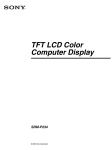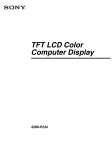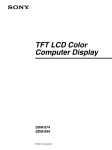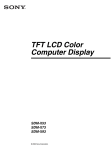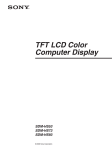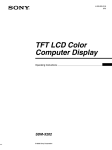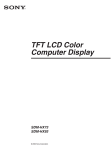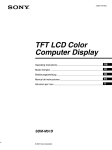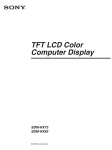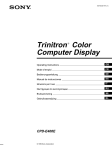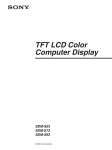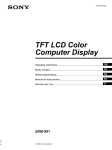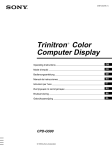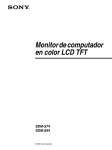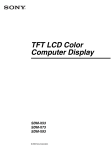Download Sony SDM-S204 Operating Instructions
Transcript
TFT LCD Color Computer Display SDM-S204 © 2003 Sony Corporation Owner’s Record The model and serial numbers are located at the rear of the unit. Record these numbers in the spaces provided below. Refer to them whenever you call upon your dealer regarding this product. Model No. Serial No. WARNING To prevent fire or shock hazard, do not expose the unit to rain or moisture. Dangerously high voltages are present inside the unit. Do not open the cabinet. Refer servicing to qualified personnel only. FCC Notice This equipment has been tested and found to comply with the limits for a Class B digital device, pursuant to Part 15 of the FCC Rules. These limits are designed to provide reasonable protection against harmful interference in a residential installation. This equipment generates, uses, and can radiate radio frequency energy and, if not installed and used in accordance with the instructions, may cause harmful interference to radio communications. However, there is no guarantee that interference will not occur in a particular installation. If this equipment does cause harmful interference to radio or television reception, which can be determined by turning the equipment off and on, the user is encouraged to try to correct the interference by one or more of the following measures: – Reorient or relocate the receiving antenna. – Increase the separation between the equipment and receiver. – Connect the equipment into an outlet on a circuit different from that to which the receiver is connected. – Consult the dealer or an experienced radio/TV technician for help. You are cautioned that any changes or modifications not expressly approved in this manual could void your authority to operate this equipment. NOTICE This notice is applicable for USA/Canada only. If shipped to USA/Canada, install only a UL LISTED/CSA LABELLED power supply cord meeting the following specifications: SPECIFICATIONS Plug Type Nema-Plug 5-15p Cord Type SVT or SJT, minimum 3 × 18 AWG Length Maximum 15 feet Rating Minimum 7 A, 125 V NOTICE Cette notice s’applique aux Etats-Unis et au Canada uniquement. Si cet appareil est exporté aux Etats-Unis ou au Canada, utiliser le cordon d’alimentation portant la mention UL LISTED/CSA LABELLED et remplissant les conditions suivantes: SPECIFICATIONS Type de fiche Fiche Nema 5-15 broches Cordon Type SVT ou SJT, minimum 3 × 18 AWG Longueur Maximum 15 pieds Tension Minimum 7 A, 125 V As an ENERGY STAR Partner, Sony Corporation has determined that this product meets the ENERGY STAR guidelines for energy efficiency. This monitor complies with the TCO’03 guidelines. IMPORTANTE Para prevenir cualquier mal funcionamiento y evitar daños, por favor, lea detalladamente este manual de instrucciones antes de conectar y operar este equipo. (for the gray model) If you have any questions about this product, you may call: Sony Customer Information Center 1-800-222-SONY (7669) or write to: Sony Customer Information Center 1 Sony Drive, Mail Drop #T1-11, Park Ridge, NJ 07656 Declaration of Conformity Trade Name: Model No.: Responsible Party: Address: Telephone No.: SONY SDM-S204 Sony Electronics Inc. 680 Kinderkamack Road,Oradell,NJ 07649 USA 201-930-6972 This device complies with Part 15 of the FCC Rules. Operation is subject to the following two conditions: (1) This device may not cause harmful interference, and (2) this device must accept any interference received, including interference that may cause undesired operation. BZ03 2 This monitor complies with the TCO’99 guidelines. (for the black model) Table of Contents Precautions . . . . . . . . . . . . . . . . . . . . . . . . . . . . . . . . . . . . . . . . . . . 4 Identifying parts and controls . . . . . . . . . . . . . . . . . . . . . . . . . . . . . . 5 Setup . . . . . . . . . . . . . . . . . . . . . . . . . . . . . . . . . . . . . . . . .6 Setup 1: Connect the video signal cables . . . . . . . . . . . . . . . . . . . . 6 Setup 2: Connect the power cord . . . . . . . . . . . . . . . . . . . . . . . . . . 7 Setup 3: Bundle the cords and cables . . . . . . . . . . . . . . . . . . . . . . 8 Setup 4: Turn on the monitor and computer . . . . . . . . . . . . . . . . . . 8 Setup 5: Adjust the tilt . . . . . . . . . . . . . . . . . . . . . . . . . . . . . . . . . . . 9 Selecting the input signal (INPUT button) . . . . . . . . . . . . . . . . . . . 10 Customizing Your Monitor . . . . . . . . . . . . . . . . . . . . . . .11 Navigating the menu . . . . . . . . . . . . . . . . . . . . . . . . . . . . . . . . . . . 11 PICTURE ADJUST menu . . . . . . . . . . . . . . . . . . . . . . . . . . . . 12 SCREEN menu (analog RGB signal only) . . . . . . . . . . . . . . . . 13 COLOR menu . . . . . . . . . . . . . . . . . . . . . . . . . . . . . . . . . . . . . . 14 GAMMA menu . . . . . . . . . . . . . . . . . . . . . . . . . . . . . . . . . . . . . 15 ZOOM menu . . . . . . . . . . . . . . . . . . . . . . . . . . . . . . . . . . . . . . 15 MENU POSITION menu . . . . . . . . . . . . . . . . . . . . . . . . . . . . . 15 INPUT SENSING ON/OFF menu . . . . . . . . . . . . . . . . . . . . . . . 15 LANGUAGE menu . . . . . . . . . . . . . . . . . . . . . . . . . . . . . . . . . . 16 0 RESET menu . . . . . . . . . . . . . . . . . . . . . . . . . . . . . . . . . . . . . . 16 MENU LOCK menu . . . . . . . . . . . . . . . . . . . . . . . . . . . . . . . . 16 Technical Features . . . . . . . . . . . . . . . . . . . . . . . . . . . . .17 • Macintosh is a trademark licensed to Apple Computer, Inc., registered in the U.S.A. and other countries. • Windows is registered trademark of Microsoft Corporation in the United States and other countries. • IBM PC/AT and VGA are registered trademarks of IBM Corporation of the U.S.A. • VESA and DDC are trademarks of the Video Electronics Standards Association. • ENERGY STAR is a U.S. registered mark. • Adobe and Acrobat are trademarks of Adobe Systems Incorporated. • All other product names mentioned herein may be the trademarks or registered trademarks of their respective companies. • Furthermore, “” and “” are not mentioned in each case in this manual. Power saving function . . . . . . . . . . . . . . . . . . . . . . . . . . . . . . . . . . 17 Reducing the power consumption (ECO mode) . . . . . . . . . . . . . . 17 Automatic picture quality adjustment function (analog RGB signal only) . . . . . . . . . . . . . . . . . . . . . . . . . . . . . . . . 18 Troubleshooting . . . . . . . . . . . . . . . . . . . . . . . . . . . . . . .19 On-screen messages . . . . . . . . . . . . . . . . . . . . . . . . . . . . . . . . . . . 19 Trouble symptoms and remedies . . . . . . . . . . . . . . . . . . . . . . . . . 20 Self-diagnosis function . . . . . . . . . . . . . . . . . . . . . . . . . . . . . . . . . . 22 Specifications . . . . . . . . . . . . . . . . . . . . . . . . . . . . . . . . .23 http://www.sony.net/ 3 GB Note on the LCD (Liquid Crystal Display) .Precautions Warning on power connections • Use the supplied power cord. If you use a different power cord, be sure that it is compatible with your local power supply. For the customers in the U.S.A. If you do not use the appropriate cord, this monitor will not conform to mandatory FCC standards. For the customers in the UK If you use the monitor in the UK, be sure to use the appropriate UK power cord. Example of plug types for 100 to 120 V AC for 200 to 240 V AC for 240 V AC only The equipment should be installed near an easily accessible outlet. Installation Do not install or leave the monitor: • In places subject to extreme temperatures, for example near a radiator, heating vent, or in direct sunlight. Subjecting the monitor to extreme temperatures, such as in an automobile parked in direct sunlight or near a heating vent, could cause deformations of the casing or malfunctions. • In places subject to mechanical vibration or shock. • Near any equipment that generates a strong magnetic field, such as a TV or various other household appliances. • In places subject to inordinate amounts of dust, dirt, or sand, for example near an open window or an outdoor exit. If setting up temporarily in an outdoor environment, be sure to take adequate precautions against airborne dust and dirt. Otherwise irreparable malfunctions could occur. Handling the LCD screen • Do not leave the LCD screen facing the sun as it can damage the LCD screen. Take care when you place the monitor by a window. • Do not push on or scratch the LCD screen. Do not place a heavy object on the LCD screen. This may cause the screen to lose uniformity or cause LCD panel malfunctions. • If the monitor is used in a cold place, a residual image may appear on the screen. This is not a malfunction. The screen returns to normal as the temperature rises to a normal operating level. • If a still picture is displayed for a long time, a residual image may appear for a while. The residual image will eventually disappear. • The LCD panel becomes warm during operation. This is not a malfunction. 4 Please note that the LCD screen is made with high-precision technology. However, black points or bright points of light (red, blue, or green) may appear constantly on the LCD screen, and irregular colored stripes or brightness may appear on the LCD screen. This is not malfunction. (Effective dots: more than 99.99%) Maintenance • Be sure to unplug the power cord from the power outlet before cleaning your monitor. • Clean the LCD screen with a soft cloth. If you use a glass cleaning liquid, do not use any type of cleaner containing an anti-static solution or similar additive as this may scratch the LCD screen’s coating. • Clean the cabinet, panel, and controls with a soft cloth lightly moistened with a mild detergent solution. Do not use any type of abrasive pad, scouring powder, or solvent, such as alcohol or benzine. • Do not rub, touch, or tap the surface of the screen with sharp or abrasive items such as a ballpoint pen or screwdriver. This type of contact may result in a scratched picture tube. • Note that material deterioration or LCD screen coating degradation may occur if the monitor is exposed to volatile solvents such as insecticide, or if prolonged contact is maintained with rubber or vinyl materials. Transportation • Disconnect all cables from the monitor, and grasp both side of the LCD display firmly taking care not to scratch the screen when transporting. If you drop the monitor, you may be injured or the monitor may be damaged. • When you transport this monitor for repair or shipment, use the original carton and packing materials. Disposal of the monitor • Do not dispose of this monitor with general household waste. • The fluorescent tube used in this monitor contains mercury. Disposal of this monitor must be carried out in accordance to the regulations of your local sanitation authority. Rear of the display stand Identifying parts and controls See the pages in parentheses for further details. Front of the LCD display 8 1 MENU OK MENU INPUT ECO 2 3 A 1 (Power) switch and 1 (power) indicator (pages 8, 17, 22) This switch turns the monitor on when the 1 (power) indicator lights up in red. To turn the monitor off, press this switch again. If the 1 (power) indicator does not light up, press the MAIN POWER switch (7). B MENU button (page 11) This button turns the menu screen on and off. OK 4 INPUT 5 ECO 6 C m/M buttons (page 11) These buttons are used to select the menu items and make adjustments. D OK button (page 11) This button activates the selected menu item and adjustments made using the m/M buttons (3). E INPUT button (page 10) This button switches the video input signal between INPUT1, INPUT2 and INPUT3 when two computers are connected to the monitor. F ECO button (page 17) This button is used to reduce the power consumption. Side view of the LCD display G MAIN POWER switch (page 8) This switch turns the monitor’s main power on and off. H Back cover (page 6) Remove this cover when you connect cables or cords. MAIN POWER 7 5 GB Rear of the LCD display Setup Before using your monitor, check that the following items are included in your carton: • LCD display • Power cord • HD15-HD15 video signal cable (analog RGB) • DVI-D video signal cable (digital RGB) • CD-ROM (utility software for Windows/Macintosh, Operating Instructions, etc.) • Warranty card • Quick Setup Guide Setup 1: Connect the video signal cables I AC IN connector (page 7) This connector connects the power cord (supplied). • Turn off the monitor and computer before connecting them. • When connecting the computer to the monitor’s HD15 input connector (analog RGB), refer to “Connect a computer equipped with an HD15 output connector (analog RGB).” J HD15 input connector (analog RGB) (page 7) This connector inputs analog RGB video signals (0.700 Vp-p, positive) and sync signals. K DVI-D input connector (digital RGB) (page 7) This connector inputs digital RGB video signals that comply with DVI Rev.1.0. Note • Do not touch the pins of the video signal cable connector as this might bend the pins. • Check the alignment of the HD15 connector to prevent bending the pins of the video signal cable connector. L Cable holder (page 8) This part secures cables and cords to the monitor. M Security lock hole The security lock hole should be used with the Kensington Micro Saver Security System. Micro Saver Security System is a trademark of Kensigton. 6 1 Slide up the back cover. 2 Tilt the display forward. Connect a computer equipped with a DVI output connector (digital RGB) x Connecting to a Macintosh Using the supplied DVI-D video signal cable (digital RGB), connect the computer to the monitor’s DVI-D input connector (digital RGB). to the HD 15 input connector (analog RGB) to the DVI-D input connector (digital RGB) to the computer’s output connector HD15-HD15 video signal cable (analog RGB) (supplied) to the computer’s DVI output connector (digital RGB) Macintosh DVI-D video signal cable (digital RGB) (supplied) Connect a computer equipped with an HD15 output connector (analog RGB) Using the supplied HD15-HD15 video signal cable (analog RGB), connect the computer to the monitor’s HD 15 input connector (analog RGB). When connecting a Macintosh computer, use an adapter (not supplied), if necessary. Connect the adapter to the computer before connecting the video signal cable. Setup 2: Connect the power cord 1 Connect the supplied power cord securely to the monitor’s AC IN connector. 2 Connect the other end securely to a power outlet. Connect the computer according to the following illustrations. x Connecting to an IBM PC/AT or compatible computer to the HD 15 input connector (analog RGB) GB 1 to AC IN to the computer’s HD15 output connector (analog RGB) to power outlet 2 power cord (supplied) IBM PC/AT or compatible computer HD15-HD15 video signal cable (analog RGB) (supplied) 7 Setup 3: Bundle the cords and cables Setup 4: Turn on the monitor and computer 1 Slide up the back cover. 1 2 Remove the stand cover. 3 Secure the video signal cables using the cable holder on the cabinet. 4 Feed the power cord through the hole on the left of the stand and secure the power cord and video signal cables using the cable holder. 5 Replace the stand cover and then slide down the back cover. Please be sure that cords come out through the opening at the bottom of the stand cover, for proper placement of the stand cover. Press the MAIN POWER switch located on the right side of the monitor in the direction of the [, if it is not already pressed. Make sure the 1 (power) indicator is lit in red. Note The monitor is factory shipped with the MAIN POWER switch set to on ([). lights in red MAIN POWER 1 5 back cover 2 Press the 1 (power) switch on the front right of the monitor. The 1 (power) indicator lights up in green. 2 5 3 4 lights in green stand cover cable holder 3 Turn on the computer. 4 Press the INPUT button to select the desired input signal. The selected input’s picture appears on the screen. For more information, see “Selecting the input signal (INPUT button)” on page 10. INPUT The installation of your monitor is complete. If necessary, use the monitor’s controls to adjust the picture (page 11). 8 If no picture appears on your screen • Check that the power cord and the video signal cable are properly connected. • If “NO INPUT SIGNAL” appears on the screen: – The computer is in the power saving mode. Try pressing any key on the keyboard or moving the mouse. – Check that the input signal setting is correct by pressing the INPUT button (page 10). Setup 5: Adjust the tilt This monitor can be adjusted within the angles shown below. Grasp the sides of the LCD panel, then adjust screen angles. approx. 5° approx. 20° • If “CABLE DISCONNECTED” appears on the screen: – Check that the video signal cable is properly connected. – Check that the input signal setting is correct by pressing the INPUT button (page 10). • If “OUT OF RANGE” appears on the screen, reconnect the old monitor. Then adjust the computer’s graphics board within the following ranges. Analog RGB Digital RGB Horizontal frequency 28–92 kHz 28–75 kHz Vertical frequency 48–85 Hz 60 Hz Resolution 1600 × 1200 or less GB For more information about on-screen messages, see “Trouble symptoms and remedies” on page 20. No need for specific drivers The monitor complies with the “DDC” Plug & Play standard and automatically detects all the monitor’s information. No specific driver needs to be installed on the computer. The first time you turn on your computer after connecting the monitor, the setup Wizard may appear on the screen. In this case, follow the on-screen instructions. The Plug & Play monitor is automatically selected so that you can use this monitor. The vertical frequency is set to 60 Hz. Since flickers are unobtrusive on the monitor, you can use it as it is. You do not need to set the vertical frequency to any particular high value. approx. 175° approx. 175° To use the monitor comfortably Adjust the viewing angle of your monitor according to the height of your desk and chair, and so that light is not reflected from the screen to your eyes. Note When adjusting the screen tilt, proceed slowly and carefully, being sure not to hit the monitor against the desk. 9 Selecting the input signal (INPUT button) Press the INPUT button. The input signal change each time you press this button. INPUT On-screen message (Appears about 5 seconds on the upper left corner.) Input signal configuration INPUT1 : HD15 HD15 input connector (analog RGB) for INPUT1 INPUT2 : HD15 HD15 input connector (analog RGB) for INPUT2 INPUT3 : DVI-D DVI-D input connector (digital RGB) for INPUT3 10 4 Customizing Your Monitor Before making adjustments Adjust the item. Press the m/M buttons to make the adjustment, then press the OK button. When you press the OK button, the setting is stored, then the display returns to the previous menu. Connect the monitor and the computer, and turn them on. For the best results, wait for at least 30 minutes before making adjustments. OK , You can make numerous adjustments to your monitor using the on-screen menu. Navigating the menu 1 Display the main menu. Press the MENU button to display the main menu on your screen. P I CTURE MENU , ADJUST 5 Close the menu. Press the MENU button once to return to normal viewing. If no buttons are pressed, the menu closes automatically after about 45 seconds. MENU USER : 100 : 70 : 50 S M O OT H I N G 1 6 0 0 x 1 2 0 0 / 6 0Hz EX I T 2 Select the menu. Press the m/M buttons to display the desired menu. Press the OK button to move to the first menu item. x Resetting the adjustments to the default settings You can reset the adjustments using RESET menu. For more information about resetting the adjustments, see 0 (RESET) on page 16. OK , 3 Select the item you want to adjust. Press the m/M buttons to select the item you want to adjust, then press the OK button. OK , If is one of the menu items. When you select and press the OK button, the display returns to the previous menu. 11 GB PICTURE ADJUST menu You can adjust the following items using the PICTURE ADJUST menu. • • • • • MODE (ECO mode) BACKLIGHT CONTRAST 6 BRIGHTNESS SMOOTHING P I CTURE Press the m/M buttons to select “ BACKLIGHT” and press the OK button. The “BACKLIGHT” menu appears on the screen. 4 Press the m/M buttons to adjust the light level and press the OK button. ADJUST USER : 100 : 70 : 50 S M O OT H I N G 1 6 0 0 x 1 2 0 0 / 6 0Hz EX I T x Selecting the MODE (ECO mode) You can select the picture mode to reduce the power consumption. Note You can also select the picture mode with the ECO button (pages 5, 17) on the front of the monitor. 1 Press the MENU button. The main menu appears on the screen. 2 Press the m/M buttons to select (PICTURE ADJUST) and press the OK button. The PICTURE ADJUST menu appears on the screen. 3 Press the m/M buttons to select “USER” and press the OK button. The “MODE” menu appears on the screen. MODE HIGH MIDDLE L OW USER 1 6 0 0 x 1 2 0 0 / 6 0Hz EX I T 4 3 Press the m/M buttons to select the desired mode and press the OK button. The screen brightness is changed as the mode turns to HIGH t MIDDLE t LOW, and the power consumption is reduced. When you select “USER,” the screen brightness turns to the level you adjusted with the ECO button on the front of the monitor. For more information, see “Reducing the power consumption (ECO mode)” on page 17. x Adjusting the BACKLIGHT x Adjusting the CONTRAST 6 Adjust the picture contrast. Note The contrast cannot be adjusted when the ECO mode is set to “HIGH,” “MIDDLE,” or “LOW” (page 17). 1 Press the MENU button. The main menu appears on the screen. 2 Press the m/M buttons to select (PICTURE ADJUST) and press the OK button. The PICTURE ADJUST menu appears on the screen. 3 Press the m/M buttons to select “6 CONTRAST” and press the OK button. The “CONTRAST” menu appears on the screen. 4 Press the m/M buttons to adjust the contrast and press the OK button. x Adjusting the BRIGHTNESS Adjust the picture brightness (black level). Note The brightness cannot be adjusted when the ECO mode is set to “HIGH,” “MIDDLE,” or “LOW” (page 17). 1 Press the MENU button. The main menu appears on the screen. 2 Press the m/M buttons to select (PICTURE ADJUST) and press the OK button. The PICTURE ADJUST menu appears on the screen. 3 Press the m/M buttons to select “ BRIGHTNESS” and press the OK button. The “BRIGHTNESS” menu appears on the screen. 4 Press the m/M buttons to adjust the brightness and press the OK button. x Adjusting the SMOOTHING If the picture displayed at the FULL2 or FULL1 mode of ZOOM is not smooth, use the picture smoothing function. If the screen is too bright, adjust the backlight to make the screen easier to see. Note The backlight cannot be adjusted when the ECO mode is set to “HIGH,” “MIDDLE,” or “LOW” (page 17). 1 Press the MENU button. The main menu appears on the screen. 2 Press the m/M buttons to select (PICTURE ADJUST) and press the OK button. The PICTURE ADJUST menu appears on the screen. 12 1 Press the MENU button. The main menu appears on the screen. 2 Press the m/M buttons to select (PICTURE ADJUST) and press the OK button. The PICTURE ADJUST menu appears on the screen. 3 Press the m/M buttons to select “SMOOTHING” and press the OK button. The SMOOTHING menu appears on the screen. 4 Press the m/M buttons to select the desired mode. The smoothing effect becomes stronger in the order of TEXTtSTANDARDtGRAPHICS. • TEXT: To make the characters appear clear. (This mode is suited for text-based applications.) • STANDARD (The default setting): Standard smoothing effect. • GRAPHICS: To make the pictures appear clean. (This mode is suited for CD-ROM software such as photo images or illustrations.) Note • When you set the (ZOOM) menu to REAL, the SMOOTHING menu is not available. • 1600 × 1200 resolution signals are shown only in REAL mode and SMOOTHING is not possible. SCREEN menu (analog RGB signal only) x Make further automatic adjustments to the picture quality for the current input signal (AUTO) 1 Press the MENU button. The main menu appears on the screen. 2 Press the m/M buttons to select (SCREEN) and press the OK button. The SCREEN menu appears on the screen. 3 Press the m/M buttons to select “AUTO” and press the OK button. Make the appropriate adjustments of the screen’s phase, pitch and horizontal/vertical position for the current input signal and store them. x Adjust the picture’s sharpness manually (Phase/Pitch) You can adjust the picture’s sharpness as follows. This adjustment is effective when the computer is connected to the monitor’s HD15 input connector (analog RGB). 1 Set the resolution to 1600 × 1200 on the computer. 2 Load the CD-ROM. 3 Start the CD-ROM, select the area and model, and display the test pattern. For Windows Click [Utility] t [Windows]/[Win Utility.exe]. For Macintosh Click [Utility] t [Mac]/[Mac Utility]. 4 Press the MENU button. The main menu appears on the screen. 5 Press the m/M buttons to select (SCREEN) and press the OK button. The SCREEN menu appears on the screen. When the monitor receives an input signal, it automatically adjusts the picture’s position and sharpness (phase/pitch), and ensures that a clear picture appears on the screen (page 18). 6 Press the m/M buttons to select “PHASE” and press the OK button. The “PHASE” adjustment menu appears on the screen. Note While the automatic picture quality adjustment function is activated, only the 1 (power) switch will operate. 7 Press the m/M buttons until the horizontal stripes are at a minimum. Adjust so that the horizontal stripes are at a minimum. 8 Press the OK button. The main menu appears on the screen. If vertical stripes are observed over the entire screen, adjust the pitch using the following procedures. You can adjust the following items using the SCREEN menu. • AUTO SCREEN • PHASE AU TO • PITCH PHASE • H CENTER P I TCH H CENTER • V CENTER V CENTER GB 1 6 0 0 x 1 2 0 0 / 6 0Hz EX I T Note When receiving digital RGB signals from the DVI-D input connector, adjustment is unnecessary. x Automatic picture quality adjustment function If the automatic picture quality adjustment function of this monitor seems not to completely adjust the picture You can make further automatic adjustment of the picture quality for the current input signal (See “AUTO” below). If you still need to make further adjustments to the picture quality You can manually adjust the picture’s sharpness (phase/pitch) and position (horizontal/vertical position). These adjustments are stored in memory and automatically recalled when the monitor receives a previously input and registered input signal. 13 9 Press the m/M buttons to select “PITCH” and press the OK button. The “PITCH” adjustment menu appears on the screen. 10 Press the m/M buttons until the vertical stripes disappear. Adjust so that the vertical stripes disappear. COLOR menu You can select the picture’s color level for the white color field from the default color temperature settings. Also, if necessary, you can fine tune the color temperature. COLOR 9300K 6500K U SER AD JU ST 1 6 0 0 x 1 2 0 0 / 6 0Hz EX I T 11 Click [END] on the screen to turn off the test pattern. 1 Press the MENU button. The main menu appears on the screen. x Adjust the picture’s position manually (H CENTER /V CENTER) 2 Press the m/M buttons to select (COLOR) and press the OK button. The COLOR menu appears on the screen. 3 Press the m/M buttons to select the desired color temperature and press the OK button. Whites will change from a bluish hue to a reddish hue as the temperature is lowered from 9300K to 6500K. If the picture is not in the center of the screen, adjust the picture’s centering as follows. 1 Set the resolution to 1600 × 1200 on the computer. 2 Load the CD-ROM. 3 Start the CD-ROM, select the area and model, and display the test pattern. For Windows Click [Utility] t [Windows]/[Win Utility.exe]. For Macintosh Click [Utility] t [Mac]/[Mac Utility]. 4 Press the MENU button. The main menu appears on the screen. 5 Press the m/M buttons to select (SCREEN) and press the OK button. The SCREEN menu appears on the screen. 6 Press the m/M buttons to select “H CENTER” or “V CENTER” and press the OK button. The “H CENTER” adjustment menu or “V CENTER” adjustment menu appears on the screen. x Fine tuning the color temperature 1 Press the MENU button. The main menu appears on the screen. 2 Press the m/M buttons to select (COLOR) and press the OK button. The COLOR menu appears on the screen. 3 Press the m/M buttons to select “ADJUST” and press the OK button. The fine tuning menu for color temperature appears on the screen. USER 7 8 Press the m/M buttons to center the test pattern on the screen. R 128 G 128 B 128 1 6 0 0 x 1 2 0 0 / 6 0Hz EX I T 4 Press the m/M buttons to select R (Red) or B (Blue) and press the OK button. Then press the m/M buttons to adjust the color temperature and press the OK button. Since this adjustment changes the color temperature by increasing or decreasing the R and B components with respect to G (green), the G component is fixed. 5 Press the m/M buttons to select , then press the OK button. The new color setting is stored in memory and automatically recalled whenever “USER” is selected. The COLOR menu appears on the screen. Click [END] on the screen to turn off the test pattern. 14 ADJUSTMENT GAMMA menu You can associate the picture’s color shade on the screen with the picture’s original color shade. MENU POSITION menu You can change the menu position if it is blocking an image on the screen. GAMMA MENU POS I T I ON GAMMA 1 GAMMA 2 GAMMA 3 1 6 0 0 x 1 2 0 0 / 6 0Hz EX I T x Selecting the GAMMA 1 2 3 Press the MENU button. The main menu appears on the screen. Press the m/M buttons to select (GAMMA) and press the OK button. The GAMMA menu appears on the screen. 1 6 0 0 x 1 2 0 0 / 6 0Hz EX I T 1 Press the MENU button. The main menu appears on the screen. 2 Press the m/M buttons to select (MENU POSITION) and press the OK button. The MENU POSITION menu appears on the screen. 3 Press the m/M buttons to select the desired position and press the OK button. You can choose one of 9 positions where the menu will appear. Press the m/M buttons to select the desired mode and press the OK button. ZOOM menu The monitor is set to display the picture on the screen in full, irrespective of the picture’s mode or resolution in the default setting (FULL2). You can also view the picture in its actual aspect ratio or resolution. INPUT SENSING ON/OFF menu When you select AUTO ON in the INPUT SENSING ON/OFF menu, the monitor automatically detects an input signal to an input terminal, and changes the input automatically before the monitor goes into the power saving mode. ZOOM I NPUT SENSING FULL2 FULL1 REAL AU TO O N AU TO O F F 1 6 0 0 x 1 2 0 0 / 6 0Hz EX I T 1 6 0 0 x 1 2 0 0 / 6 0Hz EX I T 1 Press the MENU button. The main menu appears on the screen. 1 Press the MENU button. The main menu appears on the screen. 2 Press the m/M buttons to select (ZOOM) and press the OK button. The ZOOM menu appears on the screen. 2 Press the m/M buttons to select (INPUT SENSING ON/OFF) and press the OK button. The INPUT SENSING menu appears on the screen. 3 Press the m/M buttons to select the desired mode and press the OK button. • ON: When the selected input terminal has no input signal, or when you select an input terminal by the INPUT button on the monitor and the terminal has no input signal, the on-screen message appears (page 19) and the monitor checks the input signal to another input terminal automatically to change the input. When the input is changed, the selected input terminal is displayed on the left upper of the screen. When there is no input signal, the monitor goes into the power saving mode automatically. • OFF: The input is not changed automatically. Press the INPUT button to change the input. 3 Press the m/M buttons to select the desired mode. • FULL2 (The default setting): The input signal is displayed on the screen in full, irrespective of the picture’s mode or resolution. • FULL1: The input signal is displayed on the screen at its actual aspect ratio. Therefore, black bands may appear at the top and bottom of the picture, depending on the signal. • REAL: The input signal is displayed on the screen at its actual resolution. Sub-1600 × 1200 signals are displayed at the center of the screen surrounded by a black frame. Note When you use 1600 × 1200 resolution signals, the above mentioned settings are not available. The picture is displayed on the screen in full. 15 GB MENU LOCK menu LANGUAGE menu L A N G UA G E ENGL I SH FRANÇA I S DEUTSCH ESPA ÑOL I TA L I ANO Lock the control of buttons to prevent accidental adjustments or resetting. MENU LOCK ON OFF 1 6 0 0 x 1 2 0 0 / 6 0Hz EX I T 1 Press the MENU button. The main menu appears on the screen. 2 Press the m/M buttons to select (LANGUAGE) and press the OK button. The LANGUAGE menu appears on the screen. 3 Press the m/M buttons to select a language and press the OK button. • English • Français: French • Deutsch: German • Español: Spanish • Italiano: Italian • Nederlands: Dutch • Svenska: Swedish • : Russian • : Japanese • : Chinese 0 RESET menu Reset the adjustments to the default settings. RESET OK CANCEL 1 6 0 0 x 1 2 0 0 / 6 0Hz EX I T 1 Press the MENU button. The main menu appears on the screen. 2 Press the m/M buttons to select 0 (RESET) and press the OK button. The RESET menu appears on the screen. 3 Press the m/M buttons to select the desired mode and press the OK button. • OK: To reset all of the adjustment data to the default settings. Note that the “ LANGUAGE” setting is not reset by this method. • CANCEL:To cancel resetting and return to the menu screen. 16 1 6 0 0 x 1 2 0 0 / 6 0Hz EX I T 1 Press the MENU button. The main menu appears on the screen. 2 Press the m/M buttons to select (MENU LOCK) and press the OK button. The MENU LOCK menu appears on the screen. 3 Press the m/M buttons to select either “ON” or “OFF.” • ON: Only the 1 (power) switch and INPUT button will operate. If you attempt any other operation, the (MENU LOCK) icon appears on the screen. • OFF: Set “ MENU LOCK” to off. If “ MENU LOCK” has been set to “ON,” when you press the MENU button, “ MENU LOCK” is automatically selected. Technical Features Reducing the power consumption (ECO mode) If you press the ECO button on the front of the monitor repeatedly, you can select the screen brightness. Power saving function This monitor meets the power-saving guidelines set by VESA, ENERGY STAR, and NUTEK. If the monitor is connected to a computer or video graphics board that is DPM (Display Power Management) Standard compliant, the monitor will automatically reduce power consumption as shown below. ECO : USER 50 ECO Power mode Power consumption 1 (power) indicator normal operation 58 W (max.) ECO : HIGH green ECO : MIDDLE ECO mode green active off* (deep sleep) 2.7 W (max.)** orange 1 (power) off 2.7 W (max.) red E C O : L OW main power off 0 W * , off When your computer enters the “active off” mode, the input signal is cut and “NO INPUT SIGNAL” appears on the screen. After 5 seconds, the monitor enters the power saving mode. “Deep sleep” is a power saving mode defined by the Environmental Protection Agency. ** The maximum power consumption is 2.0 W in 100-120 V AC areas. Each mode appears on the screen and the screen brightness is reduced according to the mode. The menu automatically disappears after about 5 seconds. Screen brightness and power consumption are reduced as the mode changes from HIGH to MIDDLE to LOW. The default setting of the screen brightness is set to “USER”. If you select “USER,” you can adjust the backlight level by pressing the m/M buttons as when you select BACKLIGHT using the menu. Note Only when the ECO mode is set to “USER,” the BACKLIGHT, CONTRAST and BRIGHTNESS of the menu are available (page 12). 17 GB Automatic picture quality adjustment function (analog RGB signal only) When the monitor receives an input signal, it automatically adjusts the picture’s position and sharpness (phase/pitch), and ensures that a clear picture appears on the screen. The factory preset mode When the monitor receives an input signal, it automatically matches the signal to one of the factory preset modes stored in the monitor’s memory to provide a high quality picture at the center of the screen. If the input signal matches the factory preset mode, the picture appears on the screen automatically with the appropriate default adjustments. If input signals do not match one of the factory preset modes When the monitor receives an input signal that does not match one of the factory preset modes, the automatic picture quality adjustment function of this monitor is activated to ensure that a clear picture always appears on the screen (within the following monitor frequency ranges): Horizontal frequency: 28–92 kHz (analog RGB) 28–75 kHz (digital RGB) Vertical frequency: 48–85 Hz (analog RGB) 60 Hz (digital RGB) Consequently, the first time the monitor receives input signals that do not match one of the factory preset modes, the monitor may take a longer time than normal to display the picture on the screen. This adjustment data is automatically stored in memory so that next time, the monitor will function in the same way as when the monitor receives the signals that match one of the factory preset modes. If you adjust the phase, pitch, and picture position manually For some input signals, the automatic picture quality adjustment function of this monitor may not completely adjust the picture position, phase, and pitch. In this case, you can set these adjustments manually (page 13). If you set these adjustments manually, they are stored in memory as user modes and automatically recalled whenever the monitor receives the same input signals. 18 If “NO INPUT SIGNAL” appears on the screen Troubleshooting Before contacting technical support, refer to this section. On-screen messages If there is something wrong with the input signal, one of the following messages appears on the screen. To solve the problem, see “Trouble symptoms and remedies” on page 20. This indicates that no signal is being input via the currently selected connector. When INPUT SENSING ON/OFF (page 15) is set to ON, the monitor finds another input signal and changes the input automatically. I NFORMA T I ON NO I NPUT S I GNA L I NPUT # : XXXX X If “OUT OF RANGE” appears on the screen This indicates that the input signal is not supported by the monitor’s specifications. Check the following items. For more information about on-screen messages, see “Trouble symptoms and remedies” on page 20. If “xxx.x kHz / xxx Hz” is displayed This indicates that either the horizontal or vertical frequency is not supported by the monitor’s specifications. The figures indicate the horizontal and vertical frequencies of the current input signal. GO TO POWER SAVE The monitor will enter the power saving mode after about 5 seconds from the time the message is displayed. I NFORMA T I ON NO I NPUT S I GNA L I NPUT # : XXXX X GO TO POWER SAVE I NFORMA T I ON OUT OF RANGE I NPUT # : XXXXX XXX . XKH z / XXXH z If “RESOLUTION i 1600 × 1200” is displayed This indicates that the resolution is not supported by the monitor’s specifications (1600 × 1200 or less). If “CABLE DISCONNECTED” appears on the screen GB This indicates that the video signal cable has been disconnected from the currently selected connector. When INPUT SENSING ON/OFF (page 15) is set to ON, the monitor finds another input signal and changes the input automatically. I NFORMA T I ON I NFORMA T I ON OUT OF RANGE I NPUT # : XXXXX RESOL UT I ON > 1. 6 0 0 X 1 2 0 0 CAB L E D I SCONNECT ED I NPUT # : XXXXX 19 Trouble symptoms and remedies If a problem occurs as a result of a connected computer or other equipment, refer to the connected computer/equipment’s instruction manual. Use the self-diagnosis function (page 22) if the following recommendations do not resolve the problem. For further information and troubleshooting assistance, please visit Sony support website at: http://www.sony.net/ Symptom Check these items No picture 20 If the 1 (power) indicator is not lit, or if the 1 (power) indicator will not light up when the 1 (power) switch is pressed, • Check that the power cord is properly connected. • Check that the monitor’s MAIN POWER switch is on (page 8). If the 1 (power) indicator turns on in red, • Check that the 1 (power) switch is on. If the 1 (power) indicator is green or flashing orange, • Use the self-diagnosis function (page 22). If “CABLE DISCONNECTED” appears on the screen, • Check that the video signal cable is properly connected and all plugs are firmly seated in their sockets (page 6). • Check that the video input connector’s pins are not bent or pushed in. • Check that the input select setting is correct (page 10). • A non-supplied video signal cable is connected. If you connect a non-supplied video signal cable, “CABLE DISCONNECTED” may appear on the screen. This is not a malfunction. If “NO INPUT SIGNAL” appears on the screen, or the 1 (power) indicator is either orange or alternating between green and orange, • Check that the video signal cable is properly connected and all plugs are firmly seated in their sockets (page 6). • Check that the video input connector’s pins are not bent or pushed in. • Check that the input select setting is correct (page 10). If “OUT OF RANGE” appears on the screen (page 19), xProblem caused by a connected computer or other equipment, and not caused by the monitor • Check that the video frequency range is within that specified for the monitor. If you replaced an old monitor with this monitor, reconnect the old monitor and adjust the computer’s graphics board within the following ranges: Horizontal frequency: 28–92 kHz (analog RGB), 28–75 kHz (digital RGB) Vertical frequency: 48–85 Hz (analog RGB), 60 Hz (digital RGB) Resolution: 1600 × 1200 or less If using Windows, • If you replaced an old monitor with this monitor, reconnect the old monitor and do the following. Select “SONY” from the “Manufacturers” list and select “SDM-S204” from the “Models” list in the Windows device selection screen. If “SDM-S204” does not appear in the “Models” list, try “Plug & Play.” If using a Macintosh system, • When connecting a Macintosh computer, use an adapter (not supplied) if necessary. Connect the adapter to the computer before connecting the video signal cable. xProblem caused by a connected computer or other equipment, and not caused by the monitor • The computer is in the power saving mode. Try pressing any key on the keyboard or moving the mouse. • Check that your graphics board is installed properly. • Check that the computer’s power is on. • Restart the computer. Symptom Check these items Picture flickers, bounces, oscillates, or is scrambled. • Adjust the pitch and phase (analog RGB signal only) (page 13). • Try plugging the monitor into a different AC outlet, preferably on a different circuit. • Change the orientation of the monitor. xProblem caused by a connected computer or other equipment, and not caused by the monitor • Check your graphics board manual for the proper monitor setting. • Confirm that the graphics mode (VESA, Macintosh 19'' Color, etc.) and the frequency of the input signal are supported by this monitor. Even if the frequency is within the proper range, some graphics boards may have a sync pulse that is too narrow for the monitor to sync with correctly. • This monitor does not process interlace signals. Set for progressive signals. • Adjust the computer’s refresh rate (vertical frequency) to obtain the best possible picture (60 Hz is recommended). Picture is fuzzy. • Adjust the brightness and contrast (page 12). • Adjust the pitch and phase (analog RGB signal only) (page 13). • Adjust the smoothing (page 12). xProblem caused by a connected computer or other equipment, and not caused by the monitor • Set the resolution to 1600 × 1200 on your computer. Picture is ghosting. • Eliminate the use of video cable extensions and/or video switch boxes. • Check that all plugs are firmly seated in their sockets. Picture is not centered or sized • Adjust the pitch and phase (page 13). properly (analog RGB signal only). • Adjust the picture position (page 14). Note that some video modes do not fill the screen to the edges. Picture is too small. • Set the zoom setting to “FULL2” (page 15). GB xProblem caused by a connected computer or other equipment, and not caused by the monitor • Set the resolution to 1600 × 1200 on your computer. Picture is dark. • • • • • Wavy or elliptical pattern (moire) is visible. • Adjust the pitch and phase (analog RGB signal only) (page 13). Color is not uniform. • Adjust the pitch and phase (analog RGB signal only) (page 13). White does not look white. • Adjust the color temperature (page 14). Monitor buttons do not operate ( appears on the screen). • If “MENU LOCK” is set to “ON,” set it to “OFF” (page 16). Resolution displayed on the menu screen is incorrect. • Depending on the graphics board setting, the resolution displayed on the menu screen may not coincide with the one set on the computer. After turning off the main power, the 1 (power) indicator stays bright for a while. • When the main power is on but the 1 (power) switch is not pressed, or when the monitor is in the power saving mode, if you turn the MAIN POWER switch off, the 1 (power) indicator may not turn off right away. This is not a malfunction. Adjust the brightness (page 12). Adjust the backlight (page 12). It takes a few minutes for the display to become bright after turning on the monitor. Adjust the gamma on the GAMMA menu (page 15). The screen might turn darker, depends on ECO mode you selected. 21 Displaying this monitor’s information While the monitor is receiving a video signal, press and hold the MENU button for more than 5 seconds until the information box appears. Press the MENU button again to make the box disappear. Example MENU INFORMATION MODEL : SDM-S204 SER. NO : 1234567 MANUFACTURED : 2003-40 Model name Self-diagnosis function This monitor is equipped with a self-diagnosis function. If there is a problem with your monitor or computer(s), the screen will go blank and the 1 (power) indicator will either light up in green or flash orange. If the 1 (power) indicator is lit in orange, the computer is in power saving mode. Try pressing any key on the keyboard or moving the mouse. Serial number 1 (power) indicator Week and year of manufacture If any problem persists, call your authorized Sony dealer and give the following information: • Model name: SDM-S204 • Serial number • Detailed description of the problem • Date of purchase • Name and specifications of your computer and graphics board • Type of input signals (analog RGB/digital RGB) If the picture disappears from the screen and the 1 (power) indicator is green 1 Turn off the 1 (power) switch and disconnect the video signal cables from the monitor. 2 Turn the monitor on by pressing the 1 (power) switch. If all four color bars appear (white, red, green, blue), the monitor is working properly. Reconnect the video input cables and check the condition of your computer(s). If the color bars do not appear, there is a potential monitor failure. Inform your authorized Sony dealer of the monitor’s condition. If the picture disappears from the screen and the 1 (power) indicator is flashing orange Press the 1 (power) switch twice to turn the monitor off and then on. If the 1 (power) indicator lights up in green, the monitor is working properly. If the 1 (power) indicator is still flashing, there is a potential monitor failure. Count the number of seconds between orange flashes of the 1 (power) indicator and inform your authorized Sony dealer of the monitor’s condition. Be sure to note the model name and serial number of your monitor. Also note the model name and specifications of your computer and graphics board. 22 Specifications LCD panel Panel type: a-Si TFT Active Matrix Picture size: 20.1 inch (51 cm) Input signal format RGB operating frequency* Horizontal: 28–92 kHz (analog RGB) 28–75 kHz (digital RGB) Vertical:48–85 Hz (analog RGB) 60 Hz (digital RGB) Resolution Horizontal: Max.1600 dots Vertical: Max.1200 lines Input signal levels Analog RGB video signal: 0.7 Vp-p, 75 Ω, positive SYNC signal: TTL level, 2.2 kΩ, positive or negative (Separate horizontal and vertical, or composite sync) 0.3 Vp-p, 75 Ω, negative (Sync on green) Digital RGB (DVI) signal: TMDS (Single link) Power requirements 100–240 V, 50–60 Hz, Max. 1.2 A Power consumption Max. 58W Operating temperature 5–35 °C Dimensions (width/height/depth) Display (upright): Approx. 440.5 × 447.5 × 234 mm (with stand) (17 3/8 × 17 5/8 × 9 1/4 inches) Approx. 440.5 × 354.5 × 72.5 mm (without stand) (17 3/8 × 14 × 2 7/8 inches) Mass Approx. 7.6 kg (16 lb 12 oz) (with stand) Approx. 6.2 kg (13 lb 11 oz) (without stand) Plug & Play DDC2B Accessories See page 6. GB * Recommended horizontal and vertical timing condition • Horizontal sync width duty should be more than 4.8% of total horizontal time or 0.8 µs, whichever is larger. • Horizontal blanking width should be more than 2.5 µsec. • Vertical blanking width should be more than 450 µsec. Design and specifications are subject to change without notice. 23























